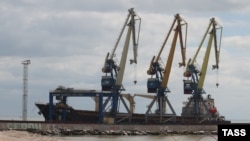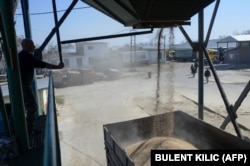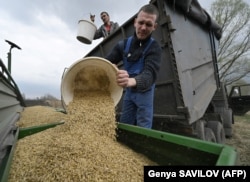Ukraine's harvested crops risk rotting in silos or ships after Russia's February invasion, triggering fears of worsening global hunger.
Before the war, Ukraine exported more than 5 million metric tons of grain every month, most of it via its ports on the Black Sea.
But now Russian warships block those ports, making such shipments impossible, and dealing a blow to global food supplies, not to mention Ukraine's agricultural sector.
Ukraine, its neighbors, and the EU, are now scrambling to find other routes to get Ukrainian grain to market, with rail emerging as a viable option despite a legion of logistical challenges.
Ukraine contributes 42 percent of the sunflower oil traded on the global market, 16 percent of the corn, and 9 percent of the wheat -- and entire countries, especially in the Middle East and Africa, are dependent on Ukrainian imports of those products.
World Food Program Executive Director David Beasley has warned that Russia's invasion of Ukraine risks turning "the breadbasket of the world to breadlines" for millions of people.
Russia has said it will lift the blockade if Western sanctions are lifted, a demand Ukrainian Foreign Minister Dmytro Kuleba has characterized as an attempt at "blackmail."
Ukraine also accuses Russia of looting its grain and trying to sell it to other countries, and the UN says there is anecdotal evidence backing that charge.
Lithuanian Foreign Minister Gabrielius Landsbergis has proposed creating a naval mission involving a "coalition of the willing" to escort Ukrainian ships across the Black Sea. So far, that idea remains just that, amid fears of an escalation of the conflict.
While the amount of grain being shipped out -- some 760,000 metric tons in early May by rail -- experts caution that new plans to use trains to transport the grain are only a stopgap solution.
"If you look at those figures, I mean, it's good. But to put it in perspective, there are more than 20 million tons of grain in Ukraine that need to go to the outside world," said Harry Nedelcu, director of policy and business development at Rasmussen Global, a think tank founded by former NATO Secretary-General Anders Fogh Rasmussen.
"Ukraine actually still controls 80 percent of its territory. So, 80 percent of that farmland has been worked and the grains are there. It's just that 90 percent of Ukraine's exports go through Odesa mostly. And those [ports] are not available. It's very difficult to replace that by rail," Nedelcu told RFE/RL, predicting the crop conundrum could become even more of a challenge once the summer crop is harvested.
Ghost Ships
Andriy Stavnitser, co-owner of the TIS grain terminal near Odesa, says shortly after Russia launched its unprovoked invasion of Ukraine on February 24, the country's Black Sea ports halted operations, blocked by Russian mines and warships.
"There are about 80 ships stranded in Ukrainian ports. Some of them are empty. Some have cargo. Their crews are dispersed all over the world. They are essentially ghost ships that cannot leave Ukraine," Stavnitser told Current Time in mid-May.
Ukraine is losing about $15 billion by not getting grain to market, Stavnitser estimates. "It's a colossal blow to the Ukrainian economy and to Ukrainian farmers," he told Current Time, the Russian-language network led by RFE/RL in cooperation with VOA.
In Brussels, European Transport Commissioner Adina Valean called the challenge of circumventing the Russian naval blockade "gigantesque," and said on May 12 that the European Commission will work with EU governments to put in place effective new transport routes for Ukrainian grain.
The European Commission announced it was establishing what it coined "solidarity lanes" to ensure Ukraine can export grain, promising billions of euros in investment in infrastructure.
As of now, Ukrainian agricultural goods are only being taken out of Ukraine over land or on barges via the Danube River, with rail being the preferred mode of transport. But bottlenecks have arisen due to the different rail gauge used in Ukraine, dating back to the Soviet era. That means shipments are being transferred to new wagons at the border.
Ukrainian Infrastructure Minister Oleksandr Kubrakov has targeted the upgrading of rail infrastructure in western Ukraine as a priority the EU should focus on. "Rail transport can partially undertake all the transportation of agricultural products, particularly grain," he said. "However, transporting goods is difficult due to western Ukraine's low border-crossing capacity, which is not designed for transshipping such volumes."
Despite the logistical logjam and the ever-present threat of Russian military strikes, more and more Ukrainian agricultural goods are getting shipped on railroad tracks.
Some 768,300 metric tons of Ukrainian grain was exported by rail between May 1 and May 16, which compares with 642,500 metric tons in April and 415,900 metric tons in March, according to the country's state-owned railway company, Ukrzaliznytsia, cited by the Argus blog, which covers commodity markets.
Those numbers are expected to continue rising in the coming months amid deepening cooperation between Ukraine and its neighbors and partners.
Lithuania received its first rail delivery of grain from Ukraine for onward shipment from its Baltic Sea port of Klaipeda, state-owned railway company LTG said on May 24. "We expect to scale up to receiving a train per day from Ukraine, each with up to 1,500 metric tons of grain and other agricultural produce, for export via Klaipeda port," LTG spokesman Mantas Dubauskas said.
And in Austria, a train carrying 2,000 metric tons of Ukrainian corn arrived on May 6.
Standing in front of a rail car adorned with the Austrian and Ukrainian flags, Austrian Agriculture, Sustainability, and Tourism Minister Elisabeth Koestinger said the shipment marked the establishment of a "green corridor" for important cargo shipments between the two countries. "Grain and animal feed exports can't leave Ukraine via the sea route. That's why we are creating green corridors," she said.
Ukrainian Ambassador to Austria Vasyl Khymynets called the new land route an important symbol of Ukraine's cooperation with its partners. "We are looking for routes to supply the world with food," he said. Khymynets added that 600,000 metric tons of Ukrainian grain could potentially be exported every month via various land routes.
Other countries have also started setting up their own "green corridor" routes, Koestinger said. Such land routes have been used during the war to help civilians trying to flee the fighting.
Austrian Railways has already been carrying Ukrainian cargo three times a week to northern Germany via Slovakia, the Czech Republic, and Poland on trains that can carry up to 2,000 metric tons.
In what was described as a first, Czech Railroads recently transported 1,800 metric tons of Ukrainian corn to the EU. The corn cargo was due to be shipped to Egypt from the German port of Brake.
Romanian Help?
Bordering Ukraine and also with Black Sea access, Romania -- and specifically its port at Constanta -- has also played an integral part in Ukrainian efforts to circumvent Russia's naval blockade.
Trains, trucks, and barges are being used to transport Ukrainian agricultural produce from small Danube ports such as Reni and Izmayil in southwest Ukraine.
But it's time consuming and infrastructure is lacking, notes policy director Nedelcu. "There are some challenges because you have to transport by rail and you have to put it on the European railway network because it's not the same size. Then you have to go down through Romania, down to Constanta. Or you go by barge across the Danube and then you go down to Constanta."
Waiting times of up to 30 days at the customs border crossing at Sirets have been reported, according to RFE/RL's Romanian Service, and 28 days at the crossing at Halmeu.
Bulgaria says it is willing to help export Ukrainian stocks from its port in Varna and is currently upgrading its infrastructure.
The conundrum may well grow trickier in the coming months, when Ukraine's summer crops of wheat, barley, and corn are due to be harvested in July and August, also putting pressure on domestic storage capacity, UN officials have said.
And it won't only be Ukraine harvesting its crops, Nedelcu points out, highlighting another potential problem. "We have to keep in mind that it's not just Constanta, it's a few ports in Poland and elsewhere, but these countries are going to get their own grain. They have to ship their grain as well. Romania also has its own grain it has to ship," Nedelcu noted.
"Once the summer months hit, then you're basically going to have this challenge of getting...the grain from Ukraine rerouted, but also having the grain from these countries going through. So, you know, that's a challenge."



